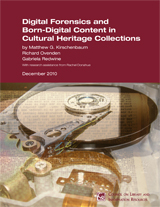 by Matthew G. Kirschenbaum, Richard Ovenden, Gabriela Redwine
by Matthew G. Kirschenbaum, Richard Ovenden, Gabriela Redwine
with research assistance from Rachel Donahue
December 2010. 93 pp. $25
ISBN 978-1-932326-37-6
CLIR pub149
PDF Download of Complete Report (1 MB file) >>
While the purview of digital forensics was once specialized to fields of law enforcement, computer security, and national defense, the increasing ubiquity of computers and electronic devices means that digital forensics is now used in a wide variety of cases and circumstances. Most records today are born digital, and libraries and other collecting institutions increasingly receive computer storage media as part of their acquisition of “papers” from writers, scholars, scientists, musicians, and public figures. This poses new challenges to librarians, archivists, and curators-challenges related to accessing and preserving legacy formats, recovering data, ensuring authenticity, and maintaining trust. The methods and tools developed by forensics experts represent a novel approach to these demands. For example, the same forensics software that indexes a criminal suspect’s hard drive allows the archivist to prepare a comprehensive manifest of the electronic files a donor has turned over for accession.
This report introduces the field of digital forensics in the cultural heritage sector and explores some points of convergence between the interests of those charged with collecting and maintaining born-digital cultural heritage materials and those charged with collecting and maintaining legal evidence.

